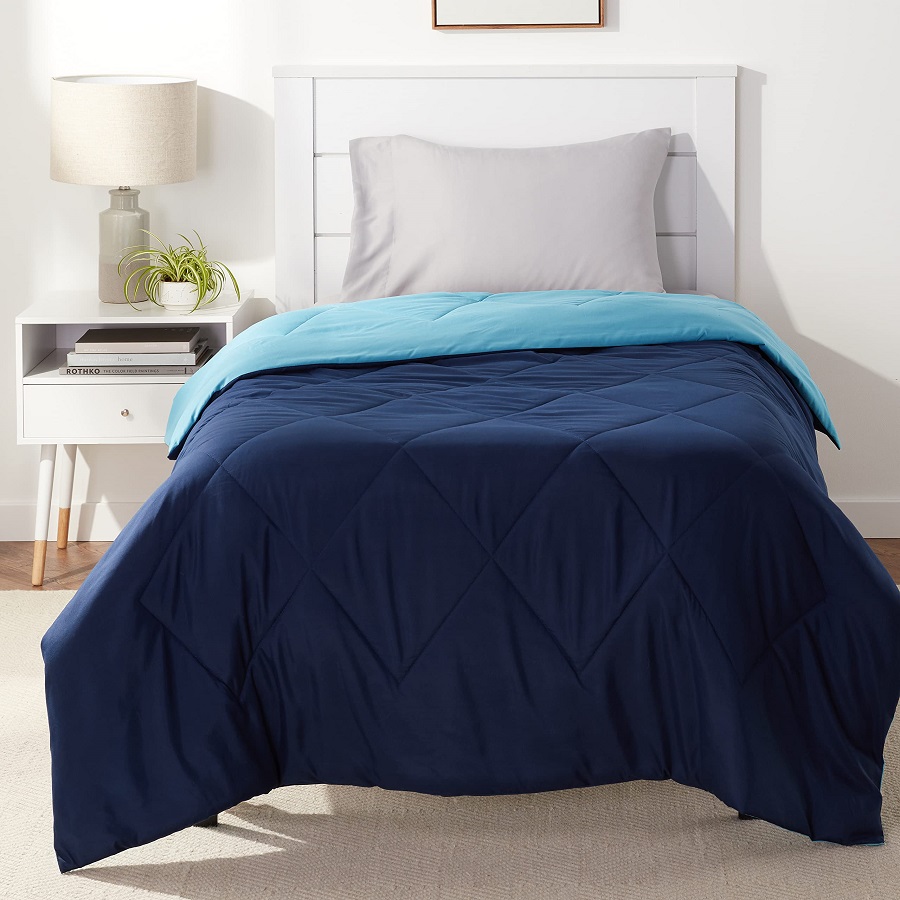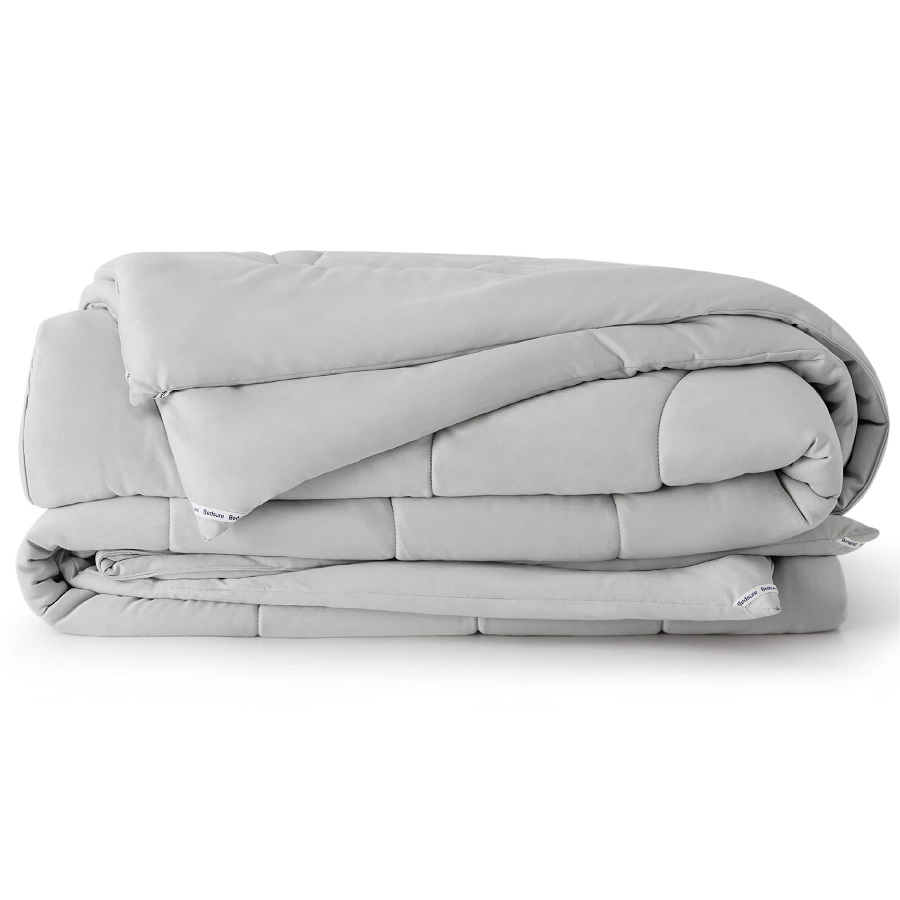Introduction
Is a comforter a blanket – When it comes to outfitting your bed or couch for a cozy night in, two popular options often come to mind: comforters and blankets. While both serve similar purposes—providing warmth and comfort—they differ significantly in terms of design, construction, usage, and care. This comprehensive guide delves into the key differences between comforters and blankets, helping you make an informed choice for your home.
Definition and Purpose
Comforter:
A comforter is typically a thicker, quilted bed covering that is filled with insulating material, such as down feathers, synthetic fibers, or cotton. It is designed to keep you warm while adding an aesthetic element to a bedroom. Comforters are often used as the primary bed covering, layered under or over sheets.
Blanket:
A blanket is a more versatile, generally thinner piece of fabric that can be made from a variety of materials, including wool, fleece, cotton, or acrylic. Blankets are primarily designed for warmth but can also serve decorative and functional purposes in various settings, like sofas or chairs.
Construction
Comforter Construction:
- Materials: Comforters usually contain a top fabric, a bottom fabric, and an insulating fill. The exterior can be made from cotton or microfiber, while the fill can vary from natural (down, wool) to synthetic (polyester).
- Quilting: Comforters are often quilted, which involves stitching the layers together. This design helps distribute the fill evenly and keeps it from shifting, ensuring consistent warmth throughout the surface.
Blanket Construction:
- Materials: Blankets come in a wide range of fabrics that can either be breathable (like cotton) or very warm (like wool). The material often determines the blanket’s weight and texture.
- No Filling: Unlike comforters, blankets do not have a filling layer, making them lighter and more breathable. They can be woven, knitted, or even fleece-based.
Thickness and Weight
Comforter:
- Generally thicker and heavier than blankets, comforters provide a substantial amount of insulation. The thickness varies greatly depending on the fill material; for instance, down comforters are plush and fluffy, while synthetic options may be more lightweight.
- Comforters can be more challenging to store due to their bulk.
Blanket:
- Blankets come in a range of weights—from lightweight throws to heavier wool options—but tend to be thinner than comforters. This makes them more adaptable for various seasons and temperatures.
- Their lightweight nature lends them to be easier to fold and store.
Aesthetic Appeal
Comforter:
- Comforters are often designed to be a focal point in a bedroom. They come in an extensive range of colors, patterns, and styles, catering to different tastes and room aesthetics.
- They often require a coordinating set of pillow shams or decorative cushions, enhancing the overall decor.
Blanket:
- While blankets can also be decorative, they are usually secondary to comforters when it comes to bedding. They are often used as layering pieces or as accents on sofas or chairs.
- Blankets can be found in a variety of textures and colors, offering some aesthetic versatility but generally less emphasis on design than comforters.
Versatility and Usage
Comforter:
- Primarily intended for use on beds, comforters can also serve functional purposes in living areas, though they are less common in those settings.
- They can double as comfort pieces in colder weather, but they may feel too warm during warmer seasons.
Blanket:
- The versatility of blankets is one of their key advantages. They can be used on beds, furniture, or taken along for picnics or camping trips.
- They can easily be layered with other bedding, allowing you to customize warmth based on the season.
Care and Maintenance
Comforter:
- Caring for comforters can be more complex. Many require special washing techniques or professional cleaning, especially those with down fill. Check the care label for specific instructions, as some comforters may be machine washable while others might need to be dry cleaned.
- Due to their bulk, they can take longer to dry, which is an important consideration in terms of maintenance.
Blanket:
- Blankets are generally easier to care for, with many materials being machine washable. Fabrics like microfiber or fleece can often be tossed straight into the washer, making them a low-maintenance option.
- They typically dry faster due to their lighter weight, which can be a significant time saver.
Cost
Comforter:
- Comforters can vary widely in price, depending on the materials used and brand. Higher-end comforters with premium down or designer patterns may come with a steeper price tag.
- Investing in a good comforter is often viewed as a long-term investment in comfort and style for your bedroom.
Blanket:
- Blankets can be more budget-friendly and are available at price points to suit a range of budgets. Basic fleece throws can be quite inexpensive, while luxurious wool options can be pricier.
- Their versatility means that you can often find value in blankets that can serve multiple purposes.

The Practical Benefits of Comforters and Blankets
1. Temperature Regulation:
One of the most significant functions of comforters and blankets is their ability to regulate temperature. As the seasons change, so can your bedding needs. A thick, down-filled comforter may be perfect for winter months, while a lightweight quilt or cotton blanket is ideal for warmer weather. This adaptability not only enhances comfort but also contributes to restful sleep.
2. Insulation:
Aside from temperature control, blankets and comforters provide warmth through insulation. Materials such as wool, down, or synthetic fibers create pockets that trap body heat, keeping you snug during cold nights. Understanding which materials work best for your climate can significantly improve your sleeping experience.
3. Layering for Comfort:
Implementing layers with different textures and weights allows for comfort customization. On cooler nights, a heavier comforter can be complemented by a soft throw blanket. On warmer evenings, a light cotton blanket can be used alone, providing versatility that adapts to your nightly comfort needs.
Aesthetic Appeal: Elevating Room Design
1. Color and Pattern:
The colors and patterns of your comforters and blankets play a crucial role in setting the mood of your bedroom. Lighter tones can create a serene atmosphere, while vibrant colors can energize the space. Floral patterns and bold graphics can add a touch of playfulness, whereas muted colors offer a more classic, understated elegance. Mixing and matching different patterns can also create a dynamic look, making your bedroom truly unique.
2. Textures:
Texture adds depth and interest to any room. Incorporating different materials—including plush fleece, soft cotton, and luxurious velvet—can elevate the overall aesthetic. Textured blankets and comforters create visual intrigue and allow you to curate a cozy, inviting environment that encourages relaxation.
3. Seasonal Decor:
Another aspect of style is the ability to change your bedding seasonally. As the weather shifts, so can your color palette and pattern choices. Cozy flannel blankets and heavier comforters work beautifully in the fall and winter, while lightweight linens and crisp cotton blankets feel refreshing in the summer, allowing your bedroom to evolve throughout the year.
Comforters vs. Blankets: What to Choose?
1. Comforters:
Comforters are typically thicker and often filled with down or synthetic materials, providing insulation and warmth. They come in a variety of styles and weights—some are reversible, offering two distinct looks. When selecting a comforter, consider factors such as fill power, weight, and ease of cleaning. A high-quality comforter can last for years with proper care and maintain its loft and warmth.
2. Blankets:
Blankets, on the other hand, are generally more versatile. They can be used layered within a bed setup or draped over chairs and sofas. From knitted throws to lightweight cotton options, blankets can add texture and color while serving different functional roles—from warm snuggles during movie night to lightweight coverage on warmer days. Moreover, they are typically easier to clean than comforters, which can require more specialized care.
Maintenance and Care
To maximize the lifespan of your comforters and blankets, regular maintenance is crucial. Here are some tips:
- Washing and Drying: Always check the care label. Most comforters and blankets can be machine washed, though some may require dry cleaning. Washing them regularly helps eliminate dust mites and allergens, contributing to a healthier sleeping environment.
- Storage: During off-seasons, store your comforters in breathable, dust-proof containers. Vacuum bags can also help, but make sure the material is completely dry to prevent mildew.
- Repair and Refresh: Small damages like loose threads or minor tears can often be mended easily. Invest in fabric fresheners or sprays specifically designed for bedding to keep them smelling fresh between washes.

Conclusion
Ultimately, the choice between a comforter and a blanket comes down to your personal preferences and needs. If you’re looking for a warm, thick covering primarily for your bed, a comforter may be the ideal choice. However, if you desire versatility and ease of care, a blanket might be the better option. Many people find value in having both, as each offers unique benefits that cater to different scenarios and preferences.
In considering what will work best for you, take into account the space where you’ll be using it, your comfort preferences, aesthetic desires, and maintenance capabilities. By understanding the key differences between comforters and blankets, you can elevate your cozy experience and make your living spaces more inviting and comfortable.
